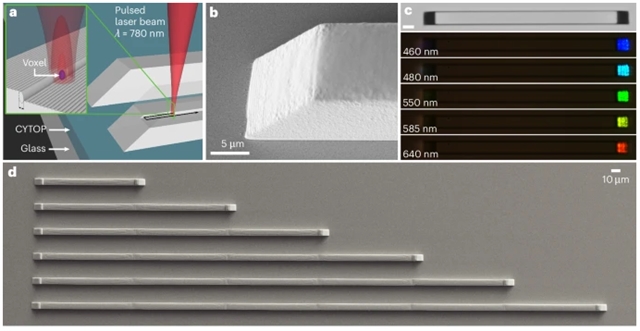
斯洛文尼亚卢布尔雅那大学Igor Muševi?团队近日实现了液晶中的光在微尺度上产生和控制纳秒级光。2025年6月3日出版的《自然—光子学》杂志发表了这项成果。
液晶的柔软性、其各向异性材料特性、对外部场的强烈响应以及在图案化表面上排列的能力使其在许多光子应用中无与伦比,如平板显示器、光调制器、可调滤波器、纠缠光子光源、激光器等。然而,尚未探索将液晶微尺度集成到微光学器件中,这些器件不仅性能类似于硅光子芯片,而且能耗更低,仅在光下工作,具有生物相容性,可以自组装。
研究组展示了一种软物质光子芯片,该芯片集成了可调液晶微激光器和激光微印刷聚合物波导。研究组演示了纳秒光脉冲对液晶微激光发射的控制,并引入了共振受激发射耗尽的概念来逐光切换光。这为设计一种全新的光子集成器件开辟了一条道路,这种器件既可以生物降解,又可以生物相容,在医学、可穿戴光子学和逻辑电路等领域有着广泛的应用。他们预计,软物质光子电路不仅在大幅减少生产步骤、使用无毒化学品和提高能源效率方面优于固态光子学,而且还可以为软物质光子学的范式开辟一条道路。
附:英文原文
Title: Microscale generation and control of nanosecond light by light in a liquid crystal
Author: Vellaichamy, Mahendran, Jagodi, Uro, Piljar, Jaka, Zaplotnik, Jaka, Mur, Urban, Jelen, Andreja, Nych, Andriy, Malkar, Deepshika, Ryzhkova, Anna V., karabot, Miha, Ravnik, Miha, Muevi, Igor
Issue&Volume: 2025-06-03
Abstract: The softness of liquid crystals, their anisotropic material properties, their strong response to external fields and their ability to align on patterned surfaces makes them unsurpassable for a number of photonic applications, such as flat-panel displays, light modulators, tunable filters, entangled photon light sources, lasers and many others. However, the microscale integration of liquid crystals into microphotonic devices that not only perform like silicon photonic chips but also use less energy, operate exclusively on light, are biocompatible and can self-assemble has not been explored. Here we demonstrate a soft-matter photonic chip that integrates tunable liquid-crystal microlasers and laser microprinted polymer waveguides. We demonstrate the control of the liquid crystal’s microlaser emission by nanosecond optical pulses and introduce the concept of resonant stimulated-emission depletion to switch the light by light. This opens a way to design an entirely new class of photonic integrated devices that can be made both biodegradable and biocompatible with a rich variety of applications in medicine, wearable photonics and logic circuits. We anticipate that soft-matter photonic circuits will not only outperform solid-state photonics in terms of a huge reduction in the number of production steps, the use of non-toxic chemicals and a better energy efficiency, but also could open an avenue to the paradigm of soft-matter photonics.
DOI: 10.1038/s41566-025-01693-2
Source: https://www.nature.com/articles/s41566-025-01693-2
